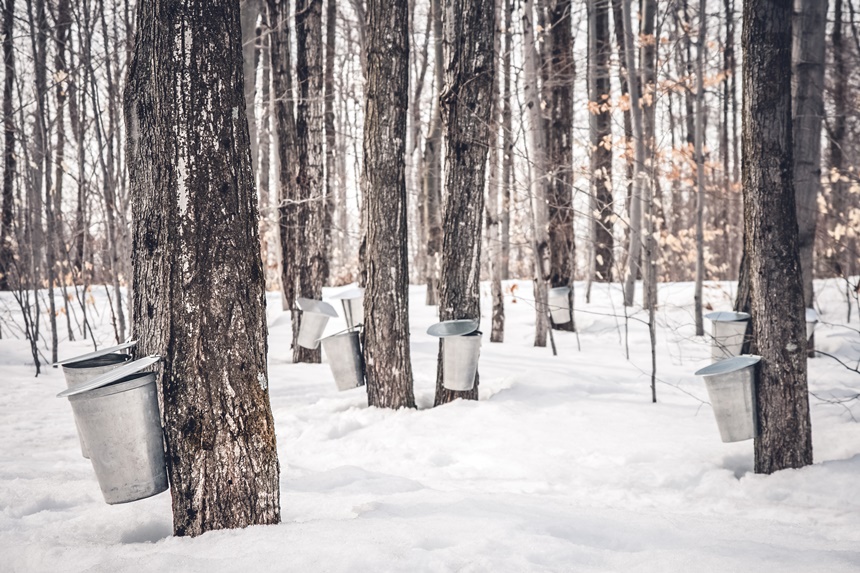We all know that foods like beans and cabbage can cause flatulence. There is one case, though, where gas gives us food. Fortunately, it’s not the same kind of gas.
From roughly mid-February through the end of March, carbon dioxide gas helps dispense an indispensable culinary delight. Yep, maple syrup is gas-powered. Apparently, the only reason maples run in spring is because their sapwood is charged with tiny gas bubbles. Carbonated wood – what’ll they think of next?
A couple of decades ago, science was at a loss to explain how sap flow worked. We observed that below-freezing nights and warm days produced a run. What we couldn’t see was the process behind this sweet miracle. The best guess we had back in the day was that water demand from (internally) developing buds pulled sap from the roots to the top. The trouble with that theory is that a column of water can only be pulled vertically about 34 feet, at which point the column will break.
Aside from maples, very few tree species have a spring sap run. In birch and butternut, the roots create pressure to force sap upward. Maples devised their own scheme. Unlike most trees, maple wood contains fiber cells that are partly filled with carbon dioxide gas. This is key to generating flow because it dissolves in sap. A lot of gas can disappear into cold liquid, but it’ll expand and bubble out as temperatures rise.
Open a bottle of carbonated water that has been sitting on your dashboard in full sun, and you’ll get a mini-geyser and a bottle of water that’s gone flat. An identical, icy-cold bottle behaves when opened, and the water stays fizzy. It’s the same idea with maple trees. More or less.
During the night, gases in wood fibers shrink as they cool, eventually dissolving into sap within the vessels. This contraction causes the tree’s internal pressure to drop, creating a suction that draws sap up from the roots. As the temperature warms in the morning, gases bubble out of the solution and expand, increasing the tree’s internal pressure and forcing sap to the upper canopy. Pressures average about 15-20 psi, and have been measured as high as 40 psi.
Rather than flowing up from the roots and out the taps during the day as was once thought, sap actually flows down from the crown (in addition to some lateral flow) toward the tap holes. When a warm day follows a sub-freezing night, sap may run for a few hours or up to several days, depending on the tree and factors like barometric pressure and wind. If temperatures remain warm at night or below freezing during the day, sap will not run.
These days, maple production sucks a lot more than it used to. The use of vacuum pumps to pull sap out of maple trees, pioneered in the early 1970s, really took off in the 2000s, and most producers now use this technology. Vacuum reduces a tree’s internal pressure, causing twice as much sap to flow from each tap.
All North American maples yield sweet sap. Although sugar (also known as hard) maples and black maples are most commonly used, producers also tap red maples if available. Silver maple is quite sweet, but they prefer wetlands and river banks – not places where maple producers typically operate. Even the much-maligned boxelder maple (Acer negundo) can be tapped. And though I hesitate to admit it, the Norway maple, which along with its red-leaf cultivars is listed as an invasive species, can be used.
If you think it’s a stretch to say maple syrup is a food, don’t blame me. Experts (I presume) from the U.S. Department of Agriculture deemed maple syrup nutritious enough to join the likes of milk, eggs, and bacon on their list of awesome stuff to eat for breakfast. Sounds good to me.
In addition to sucrose, maple sap contains organic acids, amino acids, minerals, and other compounds, many of which contribute to the flavor of maple syrup.
Beyond its incomparable taste, maple syrup is full of health benefits. A single 100-gram serving of maple syrup provides more than 100 percent of the recommended daily amount of manganese and riboflavin (vitamin B-2), and is a significant source of magnesium, zinc, and calcium.
And it could potentially even delay or arrest many cases of cognitive decline. In 2016, a Toronto-based research team announced they had identified a compound in maple syrup that may inhibit beta-amyloid brain proteins from clumping. These protein clumps are strongly linked to Alzheimer’s disease, and it is thought that blocking their formation could help prevent this tragic illness.
The freeze-thaw, dissolved-gas, pressure-differential explanation of sap flow has a couple of holes, however. While the mechanism should work with pure water, it turns out that sap only flows if it has a minimum level of sucrose. Flow should also happen in all xylem tissue, not just the living sapwood, but that’s not the case either. So, the mystery of sap flow continues.
Recently, greater numbers of maple producers have been branching out into value-added products like maple cream and candy. Another item gaining in popularity is fresh maple sap, which is bottled and pasteurized. The final step before capping the bottle is to carbonate the sap. Isn’t that where we started?
Become a Saturday Evening Post member and enjoy unlimited access. Subscribe now




Comments
Great article Paul, on this splendidly tasty natural resource. Anything that will maximize getting the most out of the trees and into bottles for the discerning consumer can only be to the good. And definitely as it comes out of the trees with no artificial additives. I bet those metal containers have to be closely guarded; especially from bears.